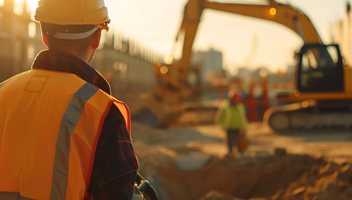Will I be in breach of health and safety law if I keep my construction site open during the COVID-19 pandemic? Is non-compliance with COVID-19 government guidance a breach of health and safety law?
The construction sector is currently grappling with an extremely challenging and fluid environment. One of those challenges is to keep on top of the non-mandatory guidance and mandatory statutory requirements being issued by the UK and Scottish Governments.
For those operating UK wide, it is also difficult to digest, and reconcile, the inconsistent guidance being issued by Westminster and by Holyrood. Scottish Government COVID-19 guidance to the construction sector confirmed that all “non-essential” works should cease (see our recent blog for further details) whereas the UK Government's position is that construction sites are not required to close, so long as it is safe to keep working.
HSE joint statements and press release
As well as considering the rafts of coronavirus specific guidance and legislation being issued by government - employers and contractors also have to give careful consideration to compliance with general duties under health and safety law in a COVID-19 world.
It is interesting to note that there is a clear difference in emphasis in joint statements issued by the HSE and others north and south of the border which broadly reflects the difference in emphasis of the Scottish and UK Governments. However, the HSE has issued a more detailed press release. The press release is not linked in the joint statement issued north of the border and does specifically refer to Public Health England guidance.
However, given the same health and safety law applies across the UK – the press release is worthy of consideration by all of those operating in the UK.
The HSE press release states “Where HSE identifies employers who are not taking action to comply with the relevant PHE [Public Health England] guidance to control public health risks, e.g. employers not taking appropriate action to socially distance …, we will consider taking a range of actions to improve control of workplace risks. These actions include the provision of specific advice to employers through to issuing enforcement notices to help secure improvements with the PHE guidance.”. A similar statement is made in the joint statement issued north of the border but it refers to “relevant public health guidance” rather than “PHE guidance”. As we know, public health guidance issued in England differs from that issued in Scotland in some respects.
Any enforcement action would be at the discretion of the HSE and should be proportionate to the risks created and the nature of the breach. However, such enforcement notices could potentially lead to site closures.
The HSE press release goes on “Keep your business open. With the exception of some non-essential shops and public venues, we are not asking any other businesses to close – indeed it is important for business to carry on.”, “If you are travelling to your workplace you will still need to observe the social distancing guidance whilst you are travelling, as far as is practical.” and “In your workplace you need to observe, where possible, the social distancing guidance.”
What does this mean?
Reviewing the HSE joint statements and press release it seems reasonable to conclude that:
- Keeping open or re-opening a construction site during the COVID-19 pandemic would not necessarily be considered by the HSE to be a breach of health and safety law. However, applying health and safety law to the circumstances of a particular site could require the closure of the site or require special arrangements to allow it to stay open;
- A failure to comply with Scottish Government guidance on the closure of non–essential sites would not necessarily be considered by the HSE to be a breach of health and safety law; and
- The HSE cannot insist upon more restrictive measures being applied in Scotland based on the more restrictive public health guidance issued in Scotland. The rationale for that conclusion is twofold (i) health and safety law is the same UK wide and there would appear to be no justification for the HSE to apply different standards north and south of the border; and (ii) the Scottish Government’s distinction between essential and non-essential sites must logically be focussed on public health objectives generally rather than protecting the health and safety of workers on a construction site specifically – as the nature and safety or otherwise of the work environment is not influenced by whether the project is considered essential or non-essential.
It would appear that employers and contractors who intend to continue working or restart work on construction sites should be carrying out a risk assessment to assess their ability to comply with current “relevant public health guidance” as well as health and safety legislation. However, it may be challenging for employers and contractors north of the border to determine what public health guidance the HSE considers to be “relevant”.
CLC Site Operating Procedures
The Construction Leadership Council has published Site Operating Procedures (SOP) which they recommend are implemented by every operational construction site and is available on their website. The guidance is intended to introduce consistent measures on sites of all sizes which align with the UK government’s recommendations on social distancing.
Conclusion
Employers and contractors must give careful consideration to compliance with general duties under health and safety law in a COVID-19 world when deciding whether to keep a site open or to re-open a site that has been closed.
It appears that the best health and safety specific guidance available at the moment is contained in the HSE joint statements and press release referred to above.
Reconciling all of the COVID-19 specific guidance and legislation with existing health and safety duties is not an easy task. If you require further assistance please do not hesitate to contact us.
Written by
Related News, Insights & Events

Performance security part three: Retentions
The most widely utilised form of performance security, being retentions and some recent measures introduced in the UK to encourage transparency in retention practices in the construction industry.

Building Safety Levy (Scotland) Bill introduced
Introduced on 5 June 2025, the Building Safety Levy (Scotland) Bill proposes a new tax which, if passed, will be known as the Scottish Building Safety Levy ("the Levy").

Performance security part two: Parent company guarantees
We are considering recent trends and what these mean in practice. Part 1 considered performance bonds; here we’ll focus on parent company guarantees (PCGs).





